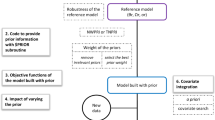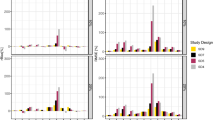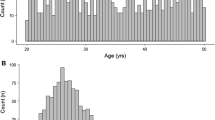Abstract
In population pharmacokinetic (PK) studies, patients' drug plasma profiles are routinely analyzed assuming that all patients took their drug at the times and in the amounts specified. However, patient non-compliance with the prescribed drug regimen is a leading source of failure to drug therapy. It has been reported that over 30% of patients routinely skip doses regardless of their disease, prognosis, or symptoms. This brings into question the assumption regarding full compliance for population PK analyses. This paper describes the estimation of population PK parameters in the presence and absence of non-compliance while either assuming full compliance or estimating compliance using a hierarchical Bayesian approach. Assessment of compliance for a given dose was limited to one of three possibilities: no dose was taken at the prescribed time, the prescribed dose was taken at the prescribed time, or twice the prescribed dose was taken at the prescribed time. Simulated data sets based on a one-compartment pharmacokinetic model with first order elimination were analyzed using WinBUGS* (Bayesian inference Using Gibbs Sampling) software. An initial feasibility simulation experiment, using a simple, but informative PK sampling design with bolus input of drug, was performed. A second simulation study was then carried out using a more realistic sampling design and first-order input of drug. The simulated sampling design included observations after known doses as well as after uncertain doses. Results from the feasibility study revealed that when compliance was estimated instead of being assumed to be 100%, the relative prediction error for clearance (CL) decreased from 0.25 to 0.10 for 60% compliance and from 0.6 to 0.2 for 35% compliance. Estimates of the interoccasion variability of clearance were improved by compliance estimation but still had substantial positive bias. Estimated of interindividual variability were relatively insensitive to compliance estimation. Estimates for volume of distribution (V) and its associated variances were not affected by incorporation of compliance estimates, perhaps due to the specific sampling design that was used. The design was relatively uninformative regarding V. In the more realistic study, estimates for CL, V and the difference between the absorption rate constant and the elimination rate constant (KA-K) were improved by the incorporation of compliance estimation. The median relative errors were reduced from 0.51 to -0.01 for CL, from 0.49 to 0.04 for V, and from 0.49 to -0.02 for Ka-K. The bias in interoccasion variances for V and CL appeared to be reduced by compliance estimation while estimates of interindividual variability were not affected in a systematic fashion. The bias in the residual error variance was decreased from a relative error of about 2 to close to 0. The use of hierarchical Bayesian modeling with the incorporation of compliance estimation decreased the bias in the typical value parameter but the effects on variance parameters were less consistent. The encouraging results of these simulation experiments will hopefully stimulate further evaluation of this methodology for the estimation of population pharmacokinetic parameters in the presence of potential patient noncompliance.
Similar content being viewed by others
REFERENCES
J. Urquhart. Patient non-compliance with drug regimens: Measurement, clinical correlates, economic impact. Eur. Heart J. 17(Suppl A): 8-15 (1996).
D. L. Sackett and R. B. Haynes (eds). Compliance with therapeutic regimens. The Johns Hopkins University Press, Baltimore, 1976.
T. Pullar, S. Kumar, H. Tindall, and M. Feely. Time to stop counting the tablets. Clin. Pharmacol. Ther. 46:163-168 (1989).
L. L-Y. Lim. Estimating compliance to study medication from serum drug levels: Application to an AIDS clinical trial of zidovudine. Biometrics 48:619-630 (1992).
A. J. Claxton, J. Cramer, and C. Pierce. A systematic review of the associations between dose regimens and medication compliance. Clinical Therap. 23:1296-1310 (2001).
I. Arnet and W. E. Haefeli. Overconsumption detected by electronic drug monitoring requires subtle interpretation. Clin. Pharmacol. Ther. 67:44-47 (2000).
E. J. Antal, T. H. Grasela, Jr., and R. B. Smith. An evaluation of population pharmacokinetics in therapeutic trials. Part III. Prospective data collection versus retrospective data assembly. Clin. Pharmacol. Ther. 46:552-559 (1989).
B. Vrijens and E. Goetghebeur. The impact of compliance in pharmacokinetic studies. Stat. Methods Med. Res. 8:247-262 (1999).
W. Wang, F. Husan, and S. C. Chow. The impact of patient compliance on drug concentration profile in multiple doses. Stat. Med., 15:659-669 (1996).
P. Girard, L. B. Sheiner, H. Kastrissios, and T. F. Blaschke. Do we need full compliance data for population pharmacokinetic analysis? J. Pharmcokin. Biopharm. 24:265-282 (1996).
P. Girard, T. F. Blaschke, H. Kastrissios, and L. B. Sheiner. A Markov mixed effect regression model for drug compliance. Statist. Med. 17:2313-2333 (1998).
E. N. Jonsson, J. R. Wade, G. Almqvist, and M. O. Karlsson. Discrimination between rival dosing histories. Pharm. Res. 14:984-991 (1997).
J. Lu, J. M. Gries, D. Verotta, and L. B. Sheiner. Selecting reliable pharmacokinetic data for explanatory analyses of clinical trials in the presence of possible noncompliance. J. Pharmacokin. Pharmacodyn., 28:343-362 (2001).
S. L. Beal and L. B. Sheiner. NONMEM Users Guide (I-VIII). GloboMax LLC, Hanover, MD, 1989-1998.
D. Spiegelhalter, A. Thomas, and N. Best. WinBUGS user manual version 1.1.1. MRC Biostatistics Unit, Cambridge, and Imperial College School of Medicine, London, UK, (1998).
D. J. Lunn, N. Best, A. Thomas, J. Wakefield, and D. Spiegelhalter. Bayesian anlaysis of population PK/PD models: General concepts and software. J. Pharmcokin. Pharmacodyn. 29:271-306 (2002).
D. J. Lunn and L. J. Aarons. Markov Chain Monte Carlo techniques for studying interoccasion and intersubject variability: Application to pharmacokinetic data. Appl. Statist. 46:73-91 (1997).
D. J. Lunn and L. J. Aarons. The pharmacokinetics of saquinavir: A Markov chain Monte Carlo population analysis. J. Pharmacokin. Biopharm. 26:47-74 (1998).
B. Smith. Bayesian Output Analysis version 0.4.3 manual. Division of Biostatistics, University of Iowa (1999).
S-plus Users Manual, MathSoft, Inc., Seattle, WA (1999).
E. M. Landaw. Optimal experimental design for biologic compartmental systems with applications to pharmacokinetics. PhD dissertation, University of California at Los Angeles, 1980.
E. de Klerk, S. van der Linden, D van der Heijden, and J. Urquhart. Facilitated analysis of data on drug regimen compliance. Stat. Med., 16:1653-1664 (1997).
Author information
Authors and Affiliations
Corresponding author
Rights and permissions
About this article
Cite this article
Mu, S., Ludden, T.M. Estimation of Population Pharmacokinetic Parameters in the Presence of Non-compliance. J Pharmacokinet Pharmacodyn 30, 53–81 (2003). https://doi.org/10.1023/A:1023297426153
Issue Date:
DOI: https://doi.org/10.1023/A:1023297426153




